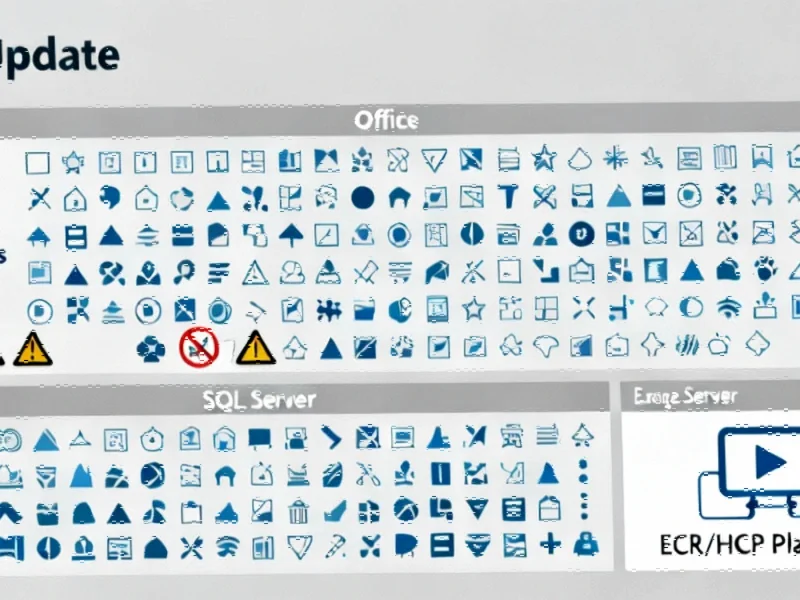Microsoft’s October update cycle has descended into chaos, exposing the fragile balancing act the company faces as it manages Windows 10’s retirement while wrestling with Windows 11’s growing pains. Two simultaneous emergency updates—one addressing a system-breaking bug affecting millions of consumers, the other patching a critical enterprise vulnerability already under active exploitation—reveal a platform at a critical crossroads. This isn’t just another patch Tuesday; it’s a stress test of Microsoft’s entire Windows ecosystem strategy at precisely the wrong moment.
Table of Contents
- The Consumer Nightmare: When Recovery Tools Can’t Recover
- Enterprise Under Fire: The WSUS Vulnerability Crisis
- Windows 10’s Ghost Haunts the Transition
- The Bigger Picture: Microsoft’s Update Quality Crisis
- What This Means for the Competitive Landscape
- The Path Forward: Restoration and Rebuilding Trust
- Related Articles You May Find Interesting
The Consumer Nightmare: When Recovery Tools Can’t Recover
For Windows 11 users, what should have been a routine October security update turned into what reports describe as a “total disaster.” The mandatory patch initially caused localhost connection issues, then escalated to a Windows Recovery Environment (WinRE) breakdown that disabled mice and keyboards, rendering affected PCs essentially unusable when attempting system recovery. The irony is palpable: the very tools designed to rescue a troubled system became inaccessible due to the update meant to protect it.
As one analysis noted, “If the mouse and keyboard don’t work in WinRE, the recovery tools are basically useless… You can’t click or type. What are you going to do?” This isn’t merely an inconvenience—it’s a fundamental breakdown of the safety net Microsoft promises users. The emergency fix, KB5070773, should download automatically, but the damage to user confidence may linger long after the technical issues are resolved.
Enterprise Under Fire: The WSUS Vulnerability Crisis
Meanwhile, in enterprise environments, a more dangerous but targeted threat emerged. The Cybersecurity and Infrastructure Security Agency (CISA) has flagged a critical remote code execution vulnerability in Windows Server Update Service (WSUS) affecting Windows Server versions from 2012 through the upcoming 2025 release. Designated CVE-2025-59287, this flaw represents every IT administrator’s nightmare: a vulnerability in the very system designed to keep their infrastructure secure.
What makes this particularly alarming is that attacks are reportedly already underway, according to security analyses. CISA has given federal agencies until November 14 to patch, but in reality, most security-conscious organizations will be racing to apply this fix immediately. The WSUS system, used by IT teams to manage and deploy updates across organizational networks, represents a crown jewel target for attackers—compromise it, and you potentially gain access to entire enterprise ecosystems.
Windows 10’s Ghost Haunts the Transition
This crisis arrives at the worst possible moment for Microsoft’s broader Windows strategy. With Windows 10 finally reaching its end-of-life, hundreds of millions of users are stranded on an unsupported platform while those who’ve migrated to Windows 11 are experiencing these stability issues. The timing couldn’t be more problematic—Microsoft needs to convince hesitant Windows 10 users to upgrade, but stories of Windows 11 update disasters provide exactly the wrong incentive.
Industry observers have noted this creates a perfect storm: organizations facing pressure to migrate from Windows 10 now see their destination platform experiencing significant growing pains. The contrast with Apple’s relatively seamless macOS updates is striking, though Microsoft’s challenge of supporting an infinitely more diverse hardware ecosystem makes direct comparisons somewhat unfair. Still, for businesses making platform decisions, these incidents register on the risk assessment radar.
The Bigger Picture: Microsoft’s Update Quality Crisis
This isn’t Microsoft’s first rodeo with problematic updates, but the simultaneous nature of these emergencies—affecting both consumer and enterprise users—suggests deeper issues in Microsoft’s quality assurance processes. Over the past several years, we’ve seen a pattern of “update Tuesday” becoming “break something Tuesday,” though rarely with consequences this severe for both segments simultaneously.
The company’s challenge is monumental: supporting multiple Windows versions across countless hardware configurations while maintaining security against increasingly sophisticated threats. However, the frequency of these incidents raises legitimate questions about whether Microsoft’s famously data-driven approach to updates—relying heavily on telemetry and gradual rollouts—is sufficient for catching critical flaws before they affect millions.
What This Means for the Competitive Landscape
These incidents arrive as Microsoft faces increased competition on multiple fronts. ChromeOS continues gaining education market share, Apple’s Mac business has seen renewed enterprise interest, and Linux desktop environments have become increasingly user-friendly. While none threaten Windows’ dominance immediately, persistent quality issues provide openings for alternatives to gain footholds in specific segments.
Particularly concerning for Microsoft should be the enterprise reaction to the WSUS vulnerability. IT departments that have built their security models around Microsoft’s update infrastructure now face questions about whether that foundation is as solid as assumed. While every platform has vulnerabilities, finding one in the update mechanism itself—especially one already being exploited—shakes confidence at a fundamental level.
The Path Forward: Restoration and Rebuilding Trust
For users, the immediate path is clear: install KB5070773 if you’re on Windows 11, and if you manage WSUS servers, apply that emergency patch immediately. But for Microsoft, the path is more complex. The company needs to not only fix these specific issues but also address the perception that Windows update quality is declining precisely when reliability matters most.
Historically, Microsoft has recovered from similar crises by demonstrating improved processes and communication. The true test will be whether we see fewer of these emergency updates in coming months, or whether this becomes the new normal for Windows users. With Windows 10’s retirement forcing migration decisions and enterprise customers evaluating their platform strategies, Microsoft can ill afford many more months like this October.
As the situation develops, all eyes will be on how Microsoft balances its aggressive security update schedule with the fundamental stability expectations users rightly maintain. In the modern threat landscape, security can’t come at the cost of reliability—both are non-negotiable for a platform serving everything from home PCs to critical infrastructure.
Related Articles You May Find Interesting
- 4MOST Telescope Ushers in New Era of Cosmic Cartography with Spectroscopic Breakthrough
- Perplexity’s Comet AI Browser Security Meltdown Exposes Fundamental Flaws in AI-Assisted Browsing
- The Motherboard Trap: How Your PC’s Foundation Can Derail Future Upgrades
- Microsoft’s OneNote Loses Ground as Productivity Users Embrace Specialized Alternatives



